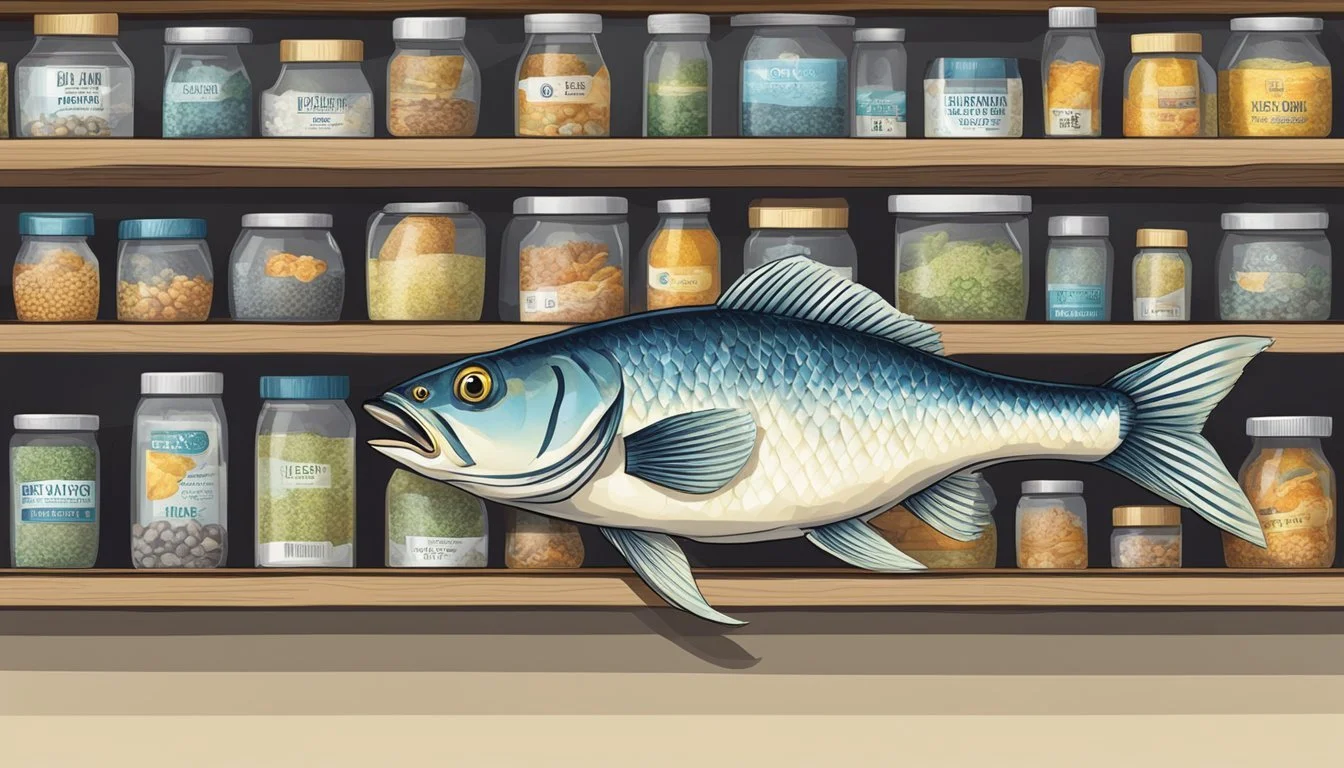Does Fish Go Bad?
Understanding Seafood Spoilage and Safety
Fish (What wine goes well with fish?), like all perishable foods, can go bad, which can pose health risks if consumed. Freshness in fish is paramount, and there are several indicators that one can check to determine its quality. Fresh fish typically has a mild scent, firm flesh, and a bright appearance. Over time, fish may spoil due to bacterial growth or oxidation, leading to a noticeable change in its color, texture, and odor.
To assess if fish has spoiled, one should look for certain telltale signs. The color of the fish is a prime indicator; fresh fish should appear vibrant and translucent, while fish that is past its prime may display a dull, grayish hue. Additionally, the presence of slimy film or a milky, opaque residue on the fish's surface can suggest bacterial action. Spoiled fish may also emit a pungent odor, ranging from overly fishy to sour or ammonia-like, which is a clear sign that the fish should not be consumed.
Proper storage is critical in preserving the quality of fish. Fish should be refrigerated at temperatures at or below 40°F and ideally should be cooked and consumed within two days after purchase. If one intends to store fish longer, freezing at 0°F can extend its shelf life for several months. It is important to note that whether fresh or frozen, once the fish displays signs of spoilage, it should not be eaten to avoid foodborne illness.
Understanding Fish Freshness
Assessing the freshness of fish is crucial because it directly influences the flavor, texture, and safety of the seafood we consume.
Fresh Fish Indicators
Texture and Touch: Fresh fish should be firm to the touch, and the flesh should spring back when pressed. The surface should be slightly wet but not excessively slimy. Appearance: A fresh fish will have a vibrant, translucent appearance. The eyes should be clear and bulging, and the gills a bright red or pink. The bloodline, which is the dark flesh along the spine, should be a rich red, not brown or grayish, indicating high quality and freshness.
Common Signs of Spoilage
Odor: A strong fishy smell or an off-odor is a telltale sign that a fish has begun to spoil. When spoilage has set in, you may also notice a sour or ammonia-like smell. Texture: Spoiled fish often has a slimy texture, which is a result of bacteria on the surface. Appearance: Look for discoloration, dullness, or milky residue on the flesh, which indicates that the fish has gone bad.
Health Risks of Spoiled Fish
Consuming spoiled fish poses risks as it can harbor bacteria leading to food poisoning. Symptoms can include gastrointestinal discomfort such as vomiting and diarrhea. Additionally, specific types of fish may contain toxins that become more prevalent as the fish spoils, increasing the risk of foodborne illness.
Proper Storage Techniques
Storing fish correctly is essential to maintain its quality and extend its shelf life. By following refrigeration best practices, understanding the nuances of freezing and thawing, and avoiding contamination, individuals can ensure their fish remains fresh and safe for consumption.
Refrigeration Best Practices
When refrigerating fish, it's important to keep the temperature of the refrigerator between 34°F and 36°F (1°C to 2°C). This temperature slows down bacterial growth and keeps the fish fresh. Below are specific steps to refrigerate fish properly:
Placement: Store the fish on a slanted tray within the refrigerator to allow any excess liquid to drain away.
Timing: Consume fresh fish within 1 to 2 days of purchasing.
Labeling: Always label the fish with the purchase or sell-by date.
Freezing and Thawing Fish
Freezing fish is a practical method to extend its shelf life for several weeks to months, depending on the type of fish. Use the following steps to freeze and thaw fish:
Freezing:
Wrap fish tightly in plastic wrap, foil, or place inside an airtight container.
Label with the type of fish, freeze date, and expiration date.
Thawing:
Thaw fish in the refrigerator or by immersing it in cold water, changing the water every 30 minutes for even thawing.
Do not refreeze fish once it has been thawed.
Avoiding Contamination
To prevent cross-contamination that can lead to spoiled fish, adhere to these practices:
Separation: Keep raw fish separate from other food items, especially ready-to-eat foods, both in the refrigerator and during preparation.
Utensils and Surfaces: Use separate cutting boards and knives for fish, and clean them thoroughly after use.
By applying these storage techniques, individuals can preserve the safety and quality of fish, ensuring that it remains a healthy and enjoyable part of their diet.
Handling and Preparation
When handling and preparing fish, whether fresh or frozen, proper techniques are crucial to ensuring quality and safety. Stepping through preparation and cooking methods helps maintain the integrity of the fish's flavor and texture and alerts the cook to signs of spoilage.
Preparing Fresh and Frozen Fish
Fresh Fish:
One must select fish with firm flesh, red gills, and a fresh oceanic smell.
At the seafood counter, fresh fish like salmon and mackerel should have vibrant skin and flesh that bounces back upon pressing.
For freshness indicators, raw fish should have no off-odors or slimy texture.
Refrigerate seafood at temperatures between 32°F and 38°F, typically in the coldest part of the refrigerator.
Before cooking, rinse the fish with cold water and pat dry with paper towels.
Frozen Fish:
Thaw frozen fish in the refrigerator or under cold running water.
Fish should be kept in its original vacuum-sealed packaging during thawing to reduce the risk of bacterial growth.
After thawing, if the flesh smells rancid or feels slimy, it may have gone bad.
Cooking Techniques and Tips
Cooking Raw Fish:
Raw fish should be cooked to an internal temperature of 145°F.
Cooking methods such as baking, grilling, broiling, or poaching can help preserve the fish's flavor and moisture content.
Cooked Fish:
Taste and Texture: Properly cooked fish is opaque and separates easily with a fork. The taste should be fresh and mild, not overly fishy or sour.
If the flavor or aroma of the cooked fish is off, it could indicate spoilage.
Signs of Spoilage: Apart from taste, visual cues like discoloration or a milky, slimy coating can indicate that the fish should not be consumed.
Cooking Specific Seafood:
Shrimp: Should turn pink and opaque when properly cooked.
Salmon: Aim for an internal temperature of 145°F, checking the thickest part of the fillet.
Remember, the key in preparing and cooking fish lies in its freshness and the care taken to preserve its natural flavor and texture for a quality meal.
Identifying Types of Fish
Before embarking on purchasing fish, it's crucial to recognize that different types of fish vary significantly. Their physical characteristics and freshness factors are not universal and can greatly influence their quality and taste.
Characteristics of Various Fish Types
Fish are commonly categorized by their fat content, which can affect both the flavor and the cooking methods suitable for each type. Fatty fish such as salmon, mackerel, sardines, and anchovies (What wine goes well with anchovies?) have a higher fat content, which contributes to their rich flavor and moist texture. These fish typically have over 5% fat and are known for their omega-3 fatty acids. In contrast, lean fish like tuna have less fat, often falling below 5%, leading to a lighter flavor and a texture that can dry out more easily if overcooked.
The appearance of the fish at the counter can also give insights into its type and quality. For example, salmon is known for its distinct pink to orange flesh, while tuna typically exhibits a deep red or pink hue.
Freshness Factors by Fish Type
Freshness indicators can differ slightly depending on whether the fish is fatty or lean, fresh, frozen, or canned.
Fresh Fish: Regardless of fat content, fresh fish should have clear, bright eyes and shiny scales. The flesh should be firm and spring back when touched. Fatty fish like salmon should appear moist as it naturally exudes more oils that keep it hydrated.
Frozen Fish: The quality of both fatty and lean frozen fish can be assessed by looking for signs of freezer burn or ice crystals. The presence of these indicates that the fish may have been stored for an extended period or not kept at a consistent, adequately low temperature.
Canned Fish: These typically include sardines, mackerel, tuna, and anchovies. Cans should be free of dents, rust, or swelling. When opened, the fish should smell fresh, not overly fishy, and should retain their characteristic shape and texture.
By understanding these distinctions, consumers can make informed decisions at the fish counter.
Shelf Life and Consumption
The shelf life of fish and guidelines for consumption are critical to ensure safety and quality. Fish is highly perishable, and various storage methods significantly impact its longevity and taste.
Estimating Fish Shelf Life
Fish shelf life varies depending on storage conditions and whether the fish is raw or cooked.
Refrigerated Raw Fish: Should be consumed within 1 to 2 days.
Refrigerated Cooked Fish: Lasts for up to 4 days.
Frozen Fish: Maintains safe consumption indefinitely, but best used within 3 to 8 months for optimal flavor and texture.
Shelf Life Table:
Storage Method Raw Fish Cooked Fish Frozen Fish (Optimal Quality) Refrigeration (34-40°F) 1-2 days Up to 4 days N/A Freezer (0°F or less) 3-8 months (best) 3 months Several months to 1 year
Tips For Consumption
To ensure the best taste and safety when consuming fish, one should follow these guidelines:
Inspect Labels: Check the sell-by dates or expiration dates; use fish before this date or freeze it.
Monitor Temperature: Store fish at the proper temperature to maintain its quality. Refrigerate at 34-40°F and freeze at 0°F or less.
Assess Quality: If the fish smells overly fishy or sour, has discoloration, or feels slimy, it's best to discard it.
Handle Leftovers Properly: Refrigerate cooked fish leftovers immediately and consume them within 2-4 days for safety and taste preservation.
Knowing these specifics can aid consumers in making informed decisions about when to consume fish to enjoy its natural flavor while staying safe.
Special Considerations
When considering the extended use of fish, whether canned, frozen, or fresh, certain factors must be closely monitored to ensure safety and quality. Handling methods, signs of spoilage, and even the packaging can all affect the shelf life and edibility of fish.
Handling Canned Fish
Canned fish such as tuna can last for years when stored in a cool, dry pantry. The shelf life typically extends well beyond the "best by" date if the can remains undamaged and unopened. Once opened, however, it should be consumed within a few days. To maintain freshness, transfer any unused canned fish to a sealed container and refrigerate.
Dealing With Freezer Burn
Freezer burn affects the texture and moisture content of fish, although it does not pose a health risk. It occurs when air reaches the fish's surface, leading to dehydration and oxidation. Fish should be tightly wrapped in plastic wrap or placed in a freezer bag to minimize exposure. While freezer burn can make the fish dry and tough, the presence of ice crystals is a common telltale sign.
Signs of Bacterial Growth
Any signs of mold, unusual stickiness, or a bad smell are reliable indicators of bacterial growth and spoilage in fish. Bad fish may also exhibit a slimy, glossy, or milky appearance. Consuming fish with bacteria can pose serious health risks; therefore, if any of these signs are evident, discard the fish immediately. It's crucial to prioritize safety and avoid consuming fish that may have gone bad.






